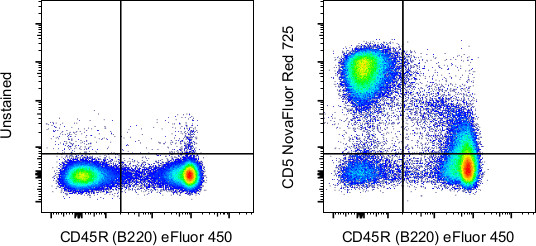Search Thermo Fisher Scientific
Invitrogen
CD5 Monoclonal Antibody (53-7.3), NovaFluor™ Red 725, eBioscience™
FIGURE: 1 / 2
CD5 Antibody (M026T03R05-A) in Flow


Product Details
M026T03R05-A
Species Reactivity
Host/Isotype
Class
Type
Clone
Conjugate
Excitation/Emission Max
Form
Concentration
Purification
Storage buffer
Contains
Storage conditions
RRID
Product Specific Information
Description: The 53-7.3 monoclonal antibody reacts with mouse CD5, a 67 kDa protein expressed by a majority of thymocytes, mature T cells and a subset of B cells. The expression of CD5 by a small subset of B cells characterizes a developmentally and functionally distinct lineage of B cells called B-1 cells. CD5 is a counter-receptor for CD72 and plays a role in the T-B cell interaction.
Each product contains 1 vial of NovaFluor conjugate and 1 vial of CellBlox Plus Blocking Buffer .
Applications Reported: The 53-7.3 antibody has been reported for use in flow cytometric analysis.
Applications Tested: The 53-7.3 antibody has been tested by flow cytometric analysis of mouse splenocytes. This can be used at less than or equal to 0.2 µg per test. A test is defined as the amount (µg) of antibody that will stain a cell sample in a final volume of 100 µL. Cell number should be determined empirically but can range from 10^5 to 10^8 cells/test. It is recommended that the antibody be carefully titrated for optimal performance in the assay of interest.
NovaFluor dyes are not compatible with DNA intercalating viability dyes. Do not use viability dyes such as propidium iodide, 7-actinomycin D (7-AAD) and DAPI. Invitrogen LIVE/DEAD Fixable Dead Cell stains are recommended for use with NovaFluor dyes.
This NovaFluor conjugate has been updated to ship with CellBlox Plus Blocking Buffer (Cat. No. (C001T06F01)). This buffer contains formulation improvements over CellBlox. CellBlox Plus Blocking Buffer is required for optimal staining with NovaFluor conjugates and should be used in all experiments where NovaFluor conjugates are used. Whenever possible, we recommend adding CellBlox Plus Blocking Buffer to antibody cocktails/master mixes prior to combining with cells. Add 5 µL per sample (regardless of the number of NovaFluors in your panel) to use the antibody cocktail as intended. For single-color controls, use 5 µL of CellBlox Blocking Buffer per 100 µL of cell sample containing 10^3 to 10^8 cells.
NovaFluor conjugates are based on Phiton™ technology utilizing novel nucleic acid dye structures that allow for engineered fluorescent signatures with consideration for spillover and spread impacts. Learn more
Excitation: 636 nm; Emission: 727 nm; Laser: 633-640 nm (Red) Laser
Target Information
CD5 is a 67 kDa human T-lymphocyte single-chain transmembrane glycoprotein. CD5 is present on all mature T-lymphocytes, on most of thymocytes and on many T-cell leukemias and lymphomas. CD5 also reacts with a subpopulation of activated B-cells and may act as a receptor in regulating T-cell proliferation. CD5 is found on 95% of thymocytes and 72% of peripheral blood lymphocytes. In lymph nodes, the main reactivity is observed in T cell areas. CD5 is expressed by many T cell leukemia, lymphomas, and activated T cells. Diseases associated with CD5 dysfunction include thymus cancer and Richter's Syndrome.
For Research Use Only. Not for use in diagnostic procedures. Not for resale without express authorization.
How to use the Panel Builder
Watch the video to learn how to use the Invitrogen Flow Cytometry Panel Builder to build your next flow cytometry panel in 5 easy steps.
References (0)
Bioinformatics
Protein Aliases: CD antigen CD5; CD5; CD5 antigen (p56 62); CD5 antigen p56-62; fCD5; Ly-1; Ly12; LyA; Lymphocyte antigen 1; Pan T cell; T-cell surface glycoprotein CD5
Gene Aliases: Cd5; Ly-1; Ly-12; Ly-A; Lyt-1
UniProt ID: (Mouse) P13379
Entrez Gene ID: (Mouse) 12507

Performance Guarantee
If an Invitrogen™ antibody doesn't perform as described on our website or datasheet,we'll replace the product at no cost to you, or provide you with a credit for a future purchase.*
Learn more
We're here to help
Get expert recommendations for common problems or connect directly with an on staff expert for technical assistance related to applications, equipment and general product use.
Contact tech support

